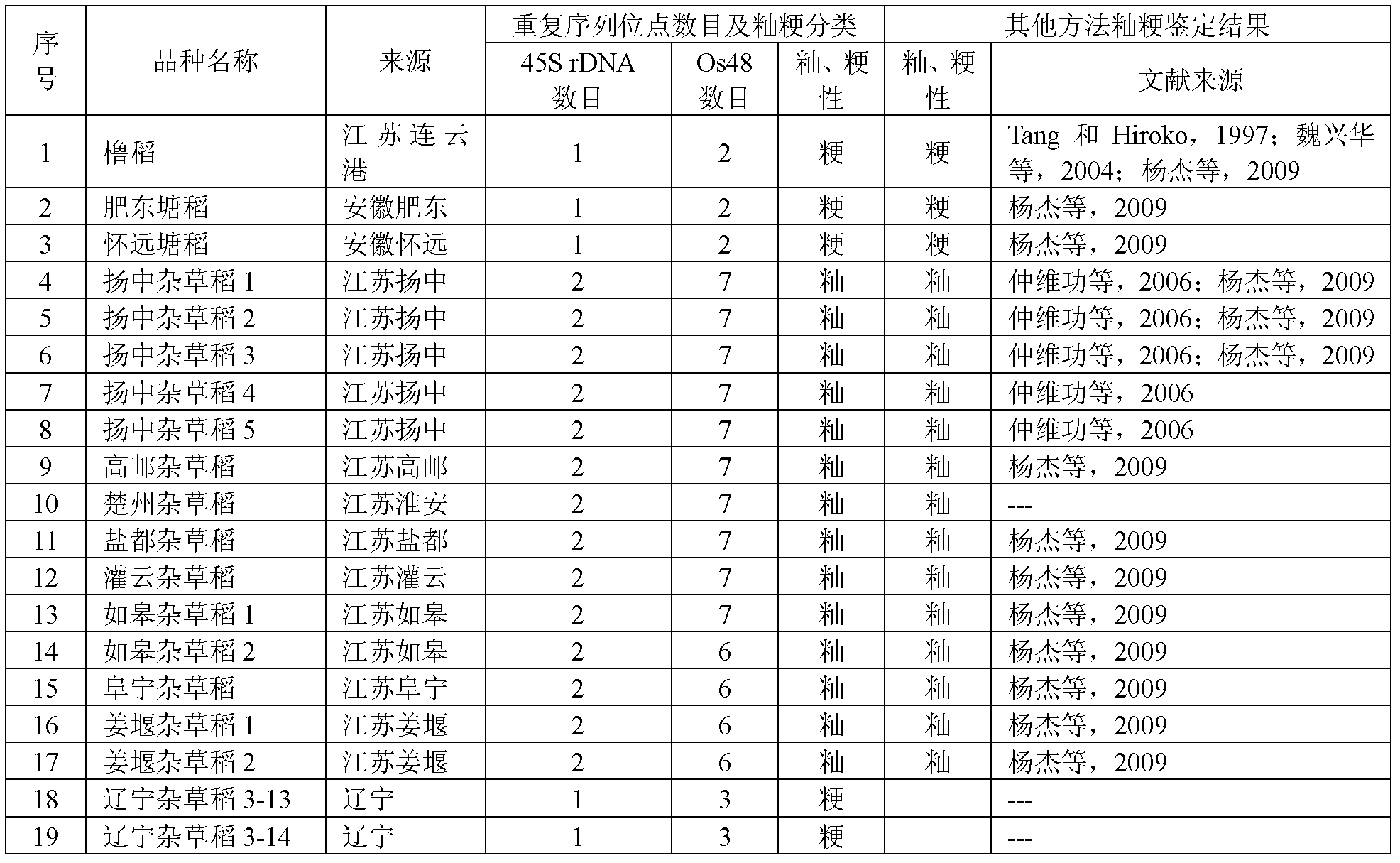Method for differentiating indica japonica of weedy rice through two repeated DNA (Deoxyribonucleic Acid) sequences
A technology of DNA repetition, rice indica and japonica, applied in the field of identification of weedy rice indica and japonica classification, to achieve the effect of high reliability, convenient young root and short time
- Summary
- Abstract
- Description
- Claims
- Application Information
AI Technical Summary
Problems solved by technology
Method used
Image
Examples
Embodiment 1
[0034] Prepare Hybridization Solution Containing Probes
[0035] a) The 45S rDNA probe is obtained as follows: The pTA71 clone used contains the wheat 45S rDNA gene sequence, and its plasmid DNA is extracted by QIAGEN plasma miniprep kit. The nick translation method is used to label the probe. The 45S rDNA probe labeling method is as follows: put 2ug plasmid DNA in a 1.5ml Eppendorf tube, add 10×Buffer (0.5M Tris HCl pH7.5, 50mM MgCl 2) 10ul, 0.5mM dNTP 10ul, 0.5mM biotin-dUTP 10ul, DNA polymerase I 2.4ul (8unit / ul), DNase I 4ul (0.1unit / ul), make up to 100ul with sterile ultrapure water, and mix well; After placed in a water bath at 15°C for 2 hours, 10ul of 0.2M EDTA was added to terminate the reaction; 3ul of the labeled probe solution was taken and detected by 1% agarose gel electrophoresis. The size of the labeled probe fragment was 100bp-500bp.
[0036] The Os48 probe was obtained as follows: pOs48 clone contains 355bp rice AA chromosome subtelomeric tandem repeat seque...
Embodiment 2
[0040] Specimen preparation of weedy rice to be identified
[0041] a) Identified weedy rice
[0042] 19 parts of weedy rice materials, including: 1 part of Feidong Tang rice from Anhui, 1 part of Huaiyuan Tang rice, 1 part of Lu rice from Jiangsu, 5 parts of Yangzhong weedy rice, 1 part of Chuzhou weedy rice, 1 part of Gaoyou weedy rice, 1 part of Yandu weedy rice, 1 part of Guanyun weedy rice, 2 parts of Rugao weedy rice, 1 part of Funing weedy rice, 2 parts of Jiangyan weedy rice, from Liaoning Weed rice 2 parts.
[0043] b) Producing and denaturing the identified weedy rice prometaphase chromosomes
[0044] The seeds of different weedy rice varieties were placed in petri dishes lined with two layers of filter paper, and an appropriate amount of distilled water was added to accelerate germination in a 25°C incubator. When the root grows to 1-2cm, cut the young root with scissors, or directly cut the young root of the weedy rice transplanted to the field, soak it in 2mM 8...
Embodiment 3
[0046] a) Fluorescence in situ hybridization
[0047] Add 22ul of the denatured hybridization solution provided in Example 1 to each denatured chromosome preparation obtained in Example 2, cover with a 22×40mm cover glass, and place it in a humid box at 37°C in an incubator for 8-10 hours . After hybridization, the cover slip was removed and washed three times with 1×PBS, 5 min each time.
PUM
 Login to View More
Login to View More Abstract
Description
Claims
Application Information
 Login to View More
Login to View More - R&D
- Intellectual Property
- Life Sciences
- Materials
- Tech Scout
- Unparalleled Data Quality
- Higher Quality Content
- 60% Fewer Hallucinations
Browse by: Latest US Patents, China's latest patents, Technical Efficacy Thesaurus, Application Domain, Technology Topic, Popular Technical Reports.
© 2025 PatSnap. All rights reserved.Legal|Privacy policy|Modern Slavery Act Transparency Statement|Sitemap|About US| Contact US: help@patsnap.com

